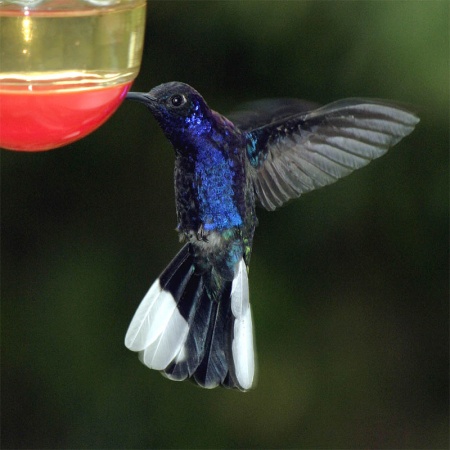(→External Links: New combined GSearch. GSearch checked template, V) |
|||
| (14 intermediate revisions by 4 users not shown) | |||
| Line 1: | Line 1: | ||
| − | + | [[Image:Violet_Sabrewing_4_by_Cedrik_K.jpg|thumb|450px|right|Male, demonstrating the pattern on the tail<br />Photo © by {{user|Cedrik+K|Cedrik K}}<br />Cielito Sur B&B, Chiriqui, [[Panama]], March 2005]] | |
;[[: Category:Campylopterus|Campylopterus]] hemileucurus | ;[[: Category:Campylopterus|Campylopterus]] hemileucurus | ||
| − | |||
==Identification== | ==Identification== | ||
| − | + | [[Image:Female_Violet_Sabrewing_by_biswasg.jpg|thumb|350px|right|Female<br />Photo © by {{user|biswasg|biswasg}}<br />[[Costa Rica]], August 2006]] | |
| − | The female | + | 13–15 cm (5-6 in); a large spectacular hummingbird with long, curved black bill and distal half of the tail white. <br /> |
| − | + | Body of the male is deep violet with green wing-[[Topography#General Anatomy|coverts]].<br /> | |
| + | The female has a violet throat and undersides pale speckled green while upperside is green to bluish-green.<br /> | ||
| + | Younger bird have uppersides similar to the female, but clues on the underside normally allows sexing. | ||
==Distribution== | ==Distribution== | ||
| − | Southern [[Mexico]] and [[Central America]] | + | Southern [[Mexico]] and [[Central America]] to western [[Panama]]. <sup>[[#References|[1]]]</sup> |
==Taxonomy== | ==Taxonomy== | ||
| + | Two subspecies are recognized<sup>[[#References|[1]]]</sup>: | ||
| + | *''C. h. hemileucurus'': | ||
| + | :*Southern [[Mexico]] south to north central [[Nicaragua]] | ||
| + | *''C. h. mellitus'': | ||
| + | :*[[Costa Rica]] and western [[Panama]] | ||
| + | |||
==Habitat== | ==Habitat== | ||
| − | + | [[Image:AS1I0907Na.jpg|thumb|350px|right|Immature<br />Photo © by {{user|scottishdude|scottishdude}}<br />[[Costa Rica]], September 2018]] | |
| + | Humid forests and edges, in the southern part of the range especially higher elevation. Also second growth forests. | ||
==Behaviour== | ==Behaviour== | ||
| − | + | ====Diet==== | |
| − | + | Their diet consists mostly of nectar. They will visit feeders around houses if provided. | |
| − | + | ====Breeding==== | |
| − | + | The nest is a bulky cup. | |
| + | ==References== | ||
| + | #{{Ref-Clements6thAug18}}#Ridgely & Gwynne 1989. Birds of Panama. Princeton Paperbacks. ISBN 0691025126 | ||
| + | #Howell & Webb, 1995. A guide to the birds of Mexico and northern Central America. Oxford University Press. ISBN 0198540124 | ||
| + | #Handbook of the Birds of the World Alive (retrieved Sept 2018) | ||
| + | {{ref}} | ||
==External Links== | ==External Links== | ||
| − | {{GSearch|Violet | + | {{GSearch|"Campylopterus hemileucurus" {{!}} "Violet Sabrewing"}} |
| + | {{GS-checked}} | ||
| + | <br /> | ||
| + | <br /> | ||
| − | [[Category:Birds]] [[Category:Campylopterus | + | [[Category:Birds]] [[Category:Campylopterus]] |
Latest revision as of 20:28, 28 December 2022
- Campylopterus hemileucurus
Identification
13–15 cm (5-6 in); a large spectacular hummingbird with long, curved black bill and distal half of the tail white.
Body of the male is deep violet with green wing-coverts.
The female has a violet throat and undersides pale speckled green while upperside is green to bluish-green.
Younger bird have uppersides similar to the female, but clues on the underside normally allows sexing.
Distribution
Southern Mexico and Central America to western Panama. [1]
Taxonomy
Two subspecies are recognized[1]:
- C. h. hemileucurus:
- C. h. mellitus:
- Costa Rica and western Panama
Habitat
Humid forests and edges, in the southern part of the range especially higher elevation. Also second growth forests.
Behaviour
Diet
Their diet consists mostly of nectar. They will visit feeders around houses if provided.
Breeding
The nest is a bulky cup.
References
- Clements, J. F., T. S. Schulenberg, M. J. Iliff, D. Roberson, T. A. Fredericks, B. L. Sullivan, and C. L. Wood. 2018. The eBird/Clements checklist of birds of the world: v2018. Downloaded from http://www.birds.cornell.edu/clementschecklist/download/
- Ridgely & Gwynne 1989. Birds of Panama. Princeton Paperbacks. ISBN 0691025126
- Howell & Webb, 1995. A guide to the birds of Mexico and northern Central America. Oxford University Press. ISBN 0198540124
- Handbook of the Birds of the World Alive (retrieved Sept 2018)
Recommended Citation
- BirdForum Opus contributors. (2024) Violet Sabrewing. In: BirdForum, the forum for wild birds and birding. Retrieved 14 September 2024 from https://www.birdforum.net/opus/Violet_Sabrewing
External Links
GSearch checked for 2020 platform.






